Samsung PM981 NVMe SSD Review
Why you can trust Tom's Hardware
512GB Performance Testing
Comparison Products
There are many more options available in the 512GB-class. Some of the fab companies were shy about packaging early 3D NAND in 16-die packages due to yield issues, but they needed the dense packages to build high-capacity M.2 SSDs. That left production lopsided with far more 512GB M.2 SSDs than 1TB models. In some cases, companies announced 1TB SSDs that never materialized. Samsung didn't have the same issue and even brought a massive 2TB M.2 drive to market with the 960 Pro series.
We have yet to test the Samsung 960 Pro 512GB, so we included the MyDigitalSSD BPX 480GB. The BPX is the current value leader for enthusiasts.
The Corsair Neutron NX500 400GB and Intel SSD 750 Series 400GB are both Add-In Card (AIC) models, so you can't use them in notebooks. The Plextor M8Se(Y) is an AIC model with a large heatsink, but you can also shuck the M.2 2280 drive from the card.
The PM981 faces stiff competition from the Samsung 960 EVO and Toshiba RD400. They cost roughly the same, but the EVO uses TLC NAND while the RD400 uses MLC NAND.
Sequential Read Performance
To read about our storage tests in depth, please check out How We Test HDDs And SSDs. We cover four-corner testing on page six of our How We Test guide.
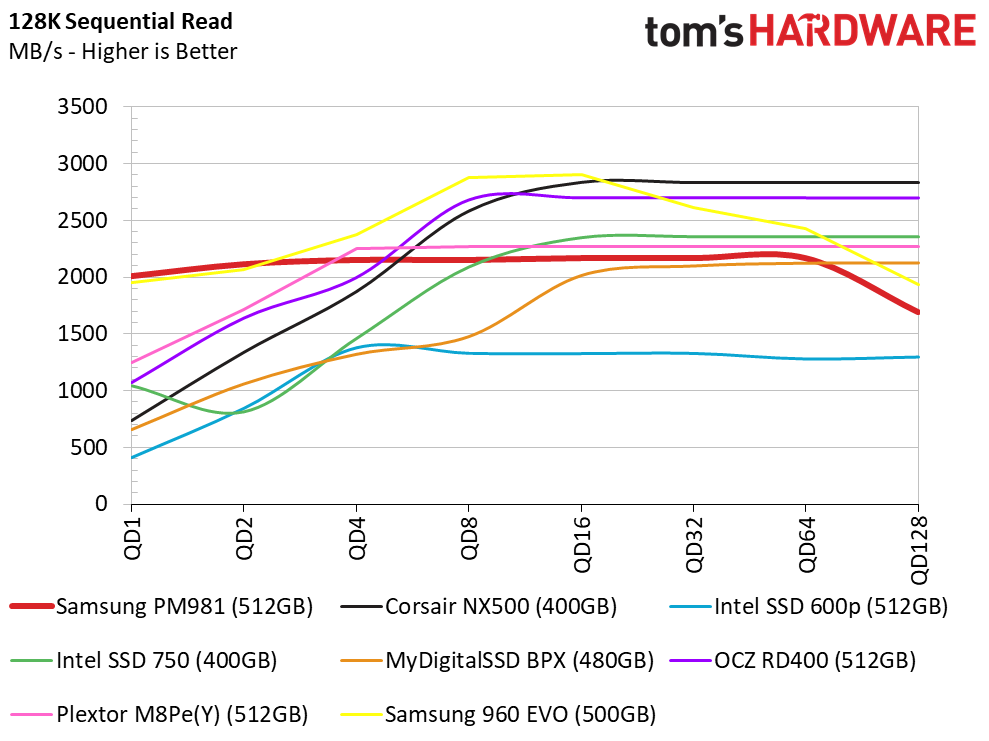

The PM981 512GB delivers the same 2,000 MB/s of sequential read throughput during the single-worker test as the larger 1TB model. The PM981's QD1 read performance is similar to the 960 EVO 500GB, but the EVO scales better up to QD16. We suspect the PM981's thermal throttling plays a role in our results.
Sequential Write Performance


The PM981 512GB rides the 1,600 MB/s line through our sequential write tests. Like many newer NVMe SSDs, increasing the queue depth with a single worker doesn't improve the sequential write performance.
Get Tom's Hardware's best news and in-depth reviews, straight to your inbox.
The PM981 512GB features a 25GB SLC buffer that provides roughly 1,800 MB/s of throughput. Performance drops below 600 MB/s once the buffer is saturated.
Random Read Performance

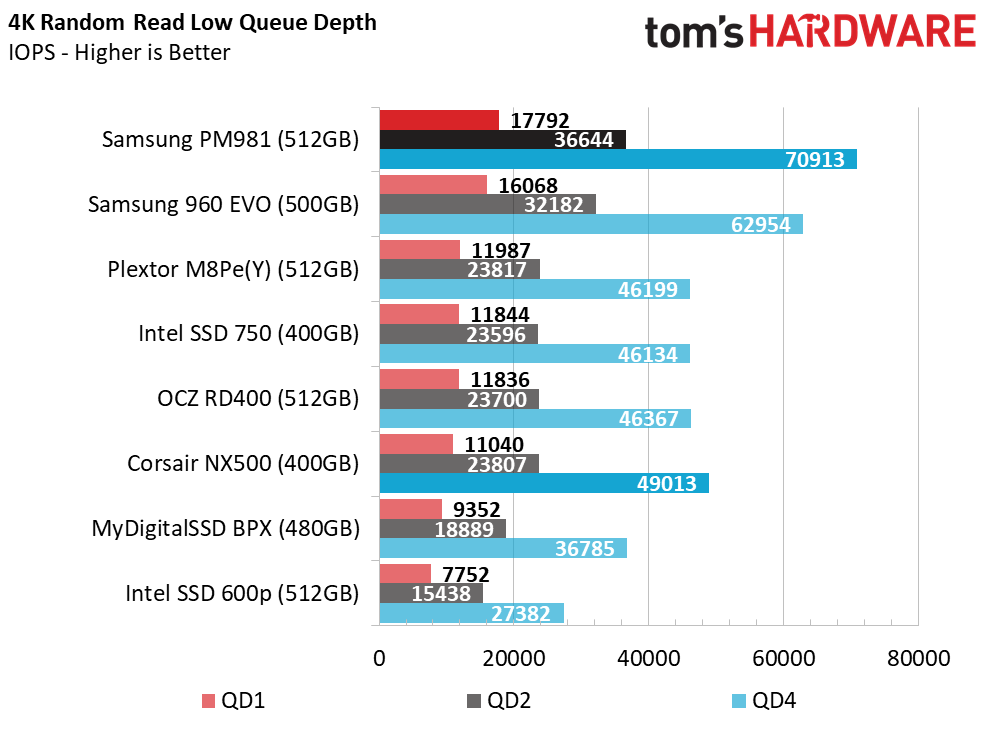

The PM981 has great random read performance. We recorded a 1,700 IOPS improvement over the 960 EVO. The improvement begins small at QD1 and increases all the way to QD128.
Random Write Performance

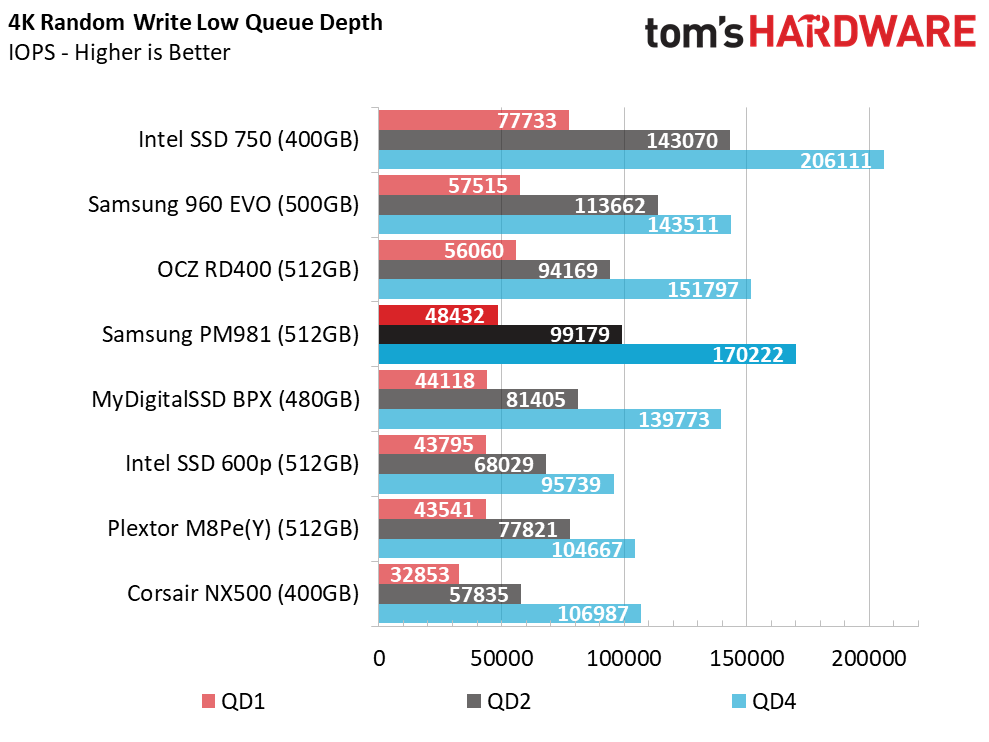

The 512GB PM981's random write performance is impressive even though it can't quite surpass the SSD 750. We've reached a point where random writes are so fast that it's difficult to see a real-world performance improvement even with exponential synthetic workload improvements.
80% Mixed Sequential Workload
We describe our mixed workload testing in detail here and describe our steady state tests here.


Samsung must have worked feverishly to increase mixed workload performance. The new PM981 512GB increases QD2 mixed sequential performance over the 960 EVO by nearly 1,100 MB/s! Samsung improved from the weakest performance in this workload to the best in just one generation.
80% Mixed Random Workload


We also recorded a big performance increase in random mixed workloads compared to the 960 EVO. The PM981 almost doubles the previous generation at QD2. The lead extends up to QD32, which is beyond what we would see with a normal workload.
Sequential Steady-State

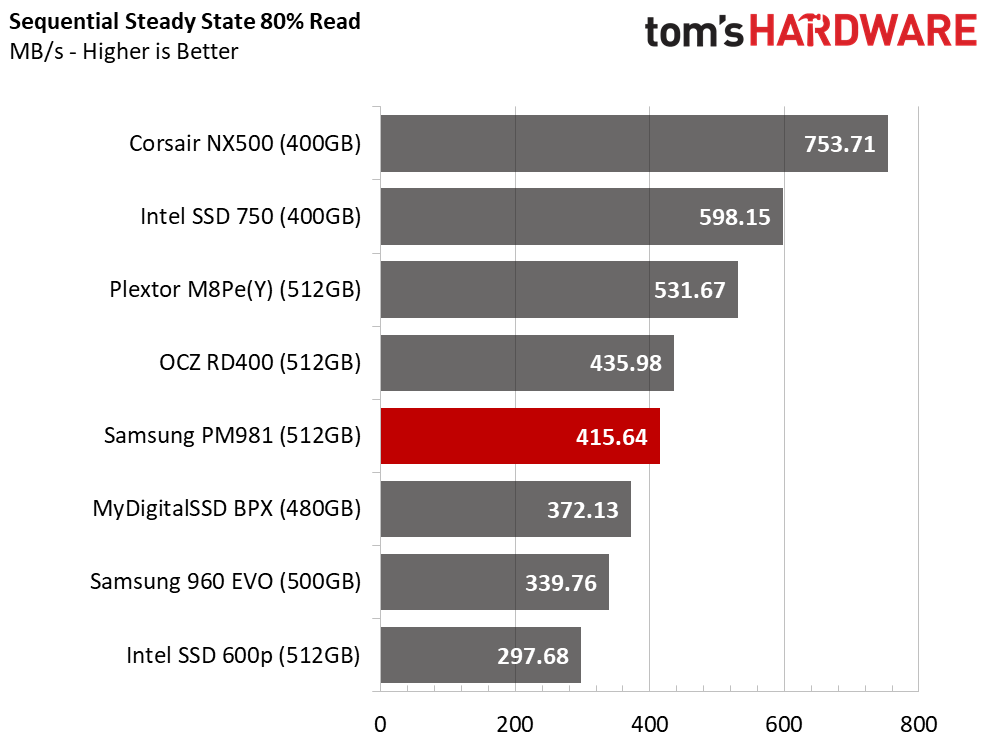

Both Toshiba and Samsung have proven that 64-layer TLC can deliver high performance under strenuous conditions with 1TB NVMe SSDs. Storage devices with TLC NAND are not perfect, but customization can help. If you want to use an M.2 SSD in a workstation, we suggest adding an aftermarket cooler like a heatsink over the controller. A little really does go a long way with NVMe cooling.
Random Steady-State


The new Phoenix controller can deliver consistent performance even with TLC NAND. Samsung managed to do the same with the Polaris controller as well as a trio of SATA controllers. Samsung builds most, if not all, of the components in its SSDs. That's an advantage over most SSD manufacturers. Vertical integration also allows the company to build tightly-integrated, and thus higher-performance, products.
PCMark 8 Real-World Software Performance
For details on our real-world software performance testing, please click here.










The PM981 faces more competition in the 512GB class and many of the competitors come armed with MLC NAND. The PM981 is literally a product ahead of its time; MLC's days are numbered.
Application Storage Bandwidth
The PM981 easily passes the 960 EVO with the previous generation controller and V-NAND memory. Every SSD that scored higher in the application test will be off the market in the next few months because the NAND will not be available.
PCMark 8 Advanced Workload Performance
To learn how we test advanced workload performance, please click here.
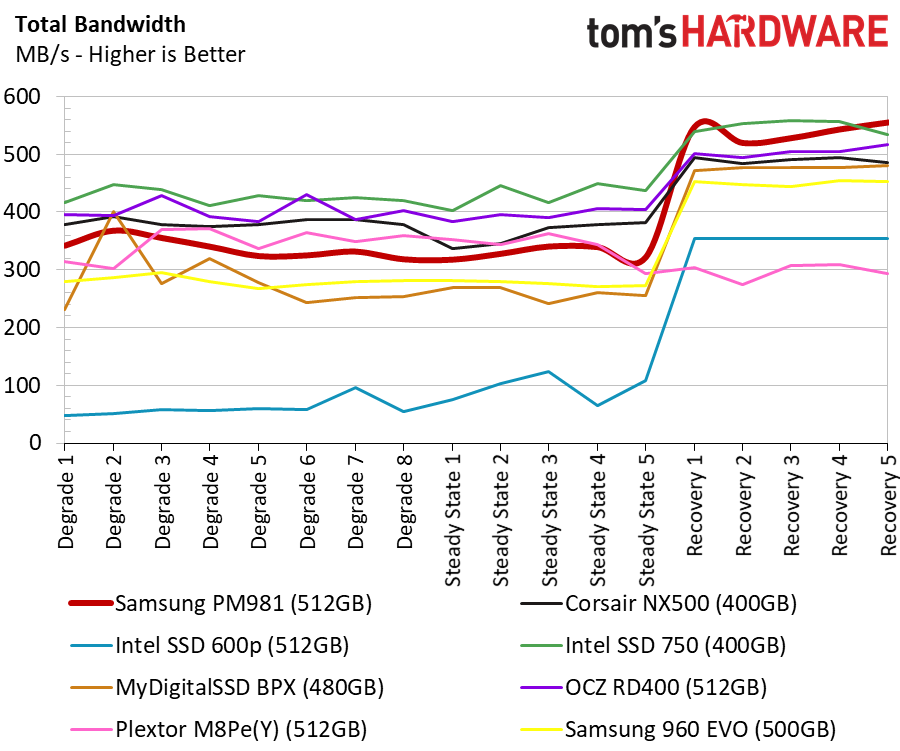


The PM981 is better suited to compare to current generation NVMe SSDs with MLC flash. Samsung lost its TLC advantage with the introduction of NVMe, at least for a single product generation. The 960 EVO battles products with MLC memory at similar price points. The PM981 not only closes that performance gap but it can be slightly faster after several months of normal desktop use.
Total Service Time



The PM981 lags slightly behind the MLC-equipped drives during sustained heavy workloads, which is a rare occurrence in a normal desktop environment. The PM981 scores among the best after we introduce some idle time.
Disk Busy Time
The same characteristics carry over to the disk busy time tests. The PM981 doesn't work very long to complete the tasks.
Responsiveness Test


We brought in the PM961 SSD for the BAPCo SYSmark 2014 SE Responsiveness Test to see how the new OEM drive compares to the outgoing model. The new OEM drive provides slightly more responsiveness but also consumes a little more power. We know the 64-layer V-NAND uses less power than the 48-layer, so it’s natural to assume the increased power consumption comes from the controller. Samsung has yet to release detail on the new Phoenix controller, so we don't know the number of processor cores or other details.
Notebook Battery Life


The Samsung PM981 delivers 109 more minutes of battery life than the 960 EVO in our BAPCo MobileMark 2012.5 test. We tested the 960 EVO with Samsung's power-sucking driver and the PM981 with the basic Microsoft "in-box" NVMe driver. The Samsung SM961 also uses the Microsoft driver, so it serves as a better apples-to-apples comparison against the PM981.
The SM961 is the OEM version that best compares to the 960 Pro, although there are a few differences. The PM981 provides a decent amount of extra battery life compared to the previous generation OEM drive, but that is only part of the story. The PM981 is one of the few NVMe SSDs that provides a long battery life while also delivering a great user experience.
MORE: Best SSDs
MORE: How We Test HDDs And SSDs
MORE: All SSD Content

Chris Ramseyer was a senior contributing editor for Tom's Hardware. He tested and reviewed consumer storage.
-
kiniku "The PM981's biggest drawback is TLC NAND, and as a result, sustained write performance took a step back." For most high-end gamers this won't be a factor unless you are writing multi-GBs of data back at a time back to the SSD. Which is why most gamers are throwing money away buying the "PRO" version of Samsung's NVE SSDs.Reply -
dgpadia Here's a question. I have a Lenovo Thinkpad Yoga 15, 20DQ Series. 200 or so SSD. Would I want to upgrade to this? Would absolutely kill my battery? If so, is there a better option. Let's assume reasonable budget (no more than $600-700, tops)Reply -
doesitmatter There's an error on page 2 in the Sequential Write Performance charts. The bar chart for QD2 128k write for the 960 Pro 1tb doesn't agree with what the line graph says. The bar chart shows it at 1544MB/s (exact same as the PM981), but the line graph shows it somewhere between 2100MB/s and 2200 MB/s, which should make it the top performer on the bar chart.Reply -
mapesdhs Why are PCMark 8 tests still included? They've never shown statistically meaningful or useful differences between products. The variation in results is miniscule.Reply -
AgentLozen ReplyGASARAKI said:Not impressed.
Hey! Thanks for the comment Gasaraki! Short, sweet, and to the point. I was sort of curious as to WHY you weren't impressed. You sort of left me hanging, but that's alright.
I think there's a lot to be excited about with the PM981. There are also a few disappointments.
I really liked the mixed work load performance. At low queue depth, the PM981 performed exceptionally well. Also, the battery life was a nice improvement over Samsung's last generation TLC drive (the 960 EVO).
With that said, I think the most interesting comparison to make is between the 960 PRO and the PM981. There were a number of sequential and random benchmarks where the PM981 wasn't as good a performer. I expected some inadequacies between MLC and TLC flash, but even the 960 EVO (with TLC flash) was beating it. The article states that the 64 layer flash being used in the PM981 was supposed to be faster and more power efficient. Is it a problem with the Phoenix controller? The author of the article claims that the culprit was probably thermal throttling.
Personally, the news I'm most happy to see is the pricing. I know $400 for 1TB probably doesn't reflect the final price of the consumer Samsung 980 drive due out in a few months, but if we could get this level of performance for $.40 per GB, that would be really terrific.
Edit: Typo and clarification -
Green_4 Can you please inclunde in this charts Intel Optane SSD 900p .... http://www.tomshardware.com/reviews/intel-optane-ssd-900p-3d-xpoint,5292-2.htmlReply -
Brian_R170 Reply20432954 said:Why are PCMark 8 tests still included? They've never shown statistically meaningful or useful differences between products. The variation in results is miniscule.
They pretty much show that the difference between the best and the worst SSD is hardly noticeable to most users.
Reviewers have found ways to use real applications to show CPU and GPU performance, but all of the SSD tests that are "meaningful" are synthetic and therefor, not actually meaningful. I liken most of the synthetic SSD benchmark data to automobile reviews that tout a vehicle's top speed. It's cool data, but not useful to nearly any owner. -
CRamseyer If you know what you are looking at all of the tests from PCMark 8 on have meaning for most of our readers. Please see the How We Test SSDs and HDDs article for details.Reply





